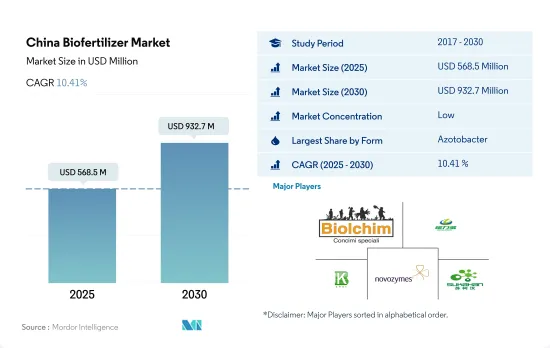Need help finding what you are looking for?
Contact Us
PUBLISHER: Mordor Intelligence | PRODUCT CODE: 1687722

PUBLISHER: Mordor Intelligence | PRODUCT CODE: 1687722
China Biofertilizer - Market Share Analysis, Industry Trends & Statistics, Growth Forecasts (2025 - 2030)
PUBLISHED:
PAGES: 136 Pages
DELIVERY TIME: 2-3 business days
SELECT AN OPTION
The China Biofertilizer Market size is estimated at 568.5 million USD in 2025, and is expected to reach 932.7 million USD by 2030, growing at a CAGR of 10.41% during the forecast period (2025-2030).

- Biofertilizers are living microorganisms that improve plant nutrition by mobilizing or increasing nutrient availability in soils. Biofertilizers are essential components of organic farming that play an important role in long-term soil fertility and sustainability by fixing atmospheric nitrogen, mobilizing fixed macro and micronutrients, or converting insoluble phosphorous in the soil into forms available to plants.
- In the Chinese biofertilizer market, Azotobacter is the most consumed biofertilizer, dominating the market with a share of 31.3%, valued at USD 137.1 million, followed by Mycorrhiza, Azospirillum, Rhizobium, and phosphate-solubilizing bacteria with shares of 22%, 22.0%, 11.6%, and 11.2%, respectively, in 2022.
- As of 2021, China achieved its "eighteenth consecutive bumper grain harvest." However, this achievement was accomplished by problems such as the chronic overuse of agricultural fertilizers. China exceeds the internationally accepted upper limit of agricultural fertilizer per unit area. As a major global agricultural producer, China proposed a fertilizer reduction and efficiency initiative in 2015 to achieve "zero fertilizer growth rate and zero fertilizer use reduction" by 2020. China achieved a fertilizer reduction of 12.8% from 2015 to 2020. This initiative increased the consumption value of biofertilizers in the Chinese agricultural sector by 7.0% during 2017-2022.
- Organic farming is also increasing in China as the demand for organic food continues to rise. From 2017 to 2022, 29.6% of organic acreage increased. Increasing organic acreage and government initiatives are expected to boost the value of the Chinese biofertilizers market by 78.8% between 2023 and 2029.
China Biofertilizer Market Trends
Country's zero growth in pesticides use and increasing exports under organic products driving the organic cultivation.
- According to the latest reports by FiBL and the IFOAM, the market for organic food in China is growing at an annual rate of 25.0%. The shift from conventional to organic is a transformation toward a more sustainable food system within China, given the USD 2.91 billion of agri-food commodities exported from China each year.
- The size of organic farmland increased rapidly in China because more people started buying organic products due to increased incomes and the increasing importance of food safety. In the last three years, China's organic planting area increased by 10%, reaching 2.4 million ha in 2020. In addition, national policies have been adopted to promote organic production, advocating the slogans that state, "lucid waters and lush mountains are invaluable assets" and "green development".
- Organic farming in China is majorly export-oriented. The products that are both exported and imported include cereals, soybeans, fruits, and vegetables. China's three northeastern provinces (Liaoning, Jilin, and Heilongjiang) support the largest organic production nationally in terms of output, volume, and area. Most organic farms located in the northern part of China (e.g., Shandong and Liaoning) supply organic vegetables and fruits to nearby cities. In addition, they export some products to Japan, South Korea, Europe, and the United States.
- With the increasing concerns of soil toxicity due to the overuse of synthetic fertilizers and pesticides that lead to soil contamination, the demand for sustainable agriculture practices and organic food production is on the rise in China. This moderately slow yet increasing shift in cultivation practices has also subsequently increased the demand for crop nutrition and protection products.
The growing demand for organic products, approximately 73% of Chinese consumers are willing to have organic food
China Biofertilizer Industry Overview
Additional Benefits:
Product Code: 64594
TABLE OF CONTENTS
1 EXECUTIVE SUMMARY & KEY FINDINGS
2 REPORT OFFERS
3 INTRODUCTION
- 3.1 Study Assumptions & Market Definition
- 3.2 Scope of the Study
- 3.3 Research Methodology
4 KEY INDUSTRY TRENDS
- 4.1 Area Under Organic Cultivation
- 4.2 Per Capita Spending On Organic Products
- 4.3 Regulatory Framework
5 MARKET SEGMENTATION (includes market size in Value in USD and Volume, Forecasts up to 2030 and analysis of growth prospects)
6 COMPETITIVE LANDSCAPE
7 KEY STRATEGIC QUESTIONS FOR AGRICULTURAL BIOLOGICALS CEOS
8 APPENDIX
Have a question?


SELECT AN OPTION
Have a question?


Questions? Please give us a call or visit the contact form.
